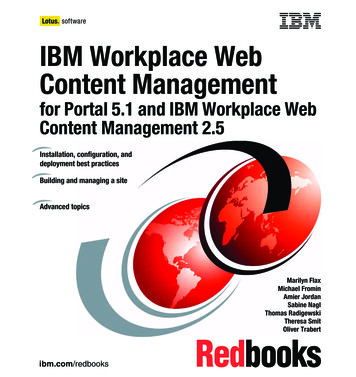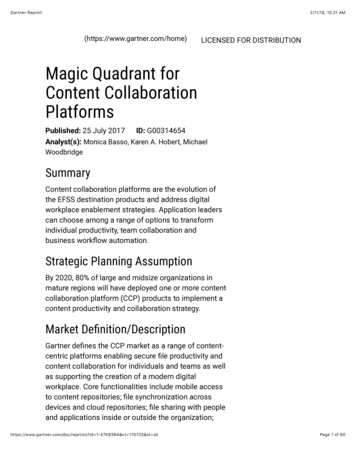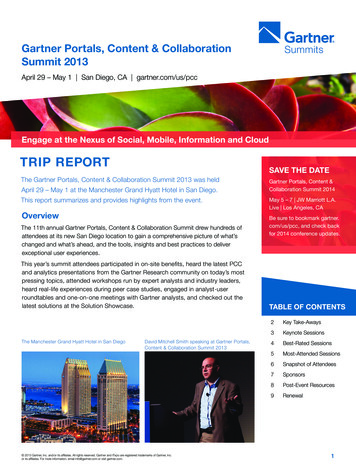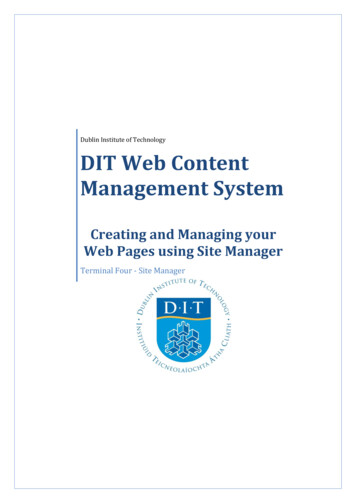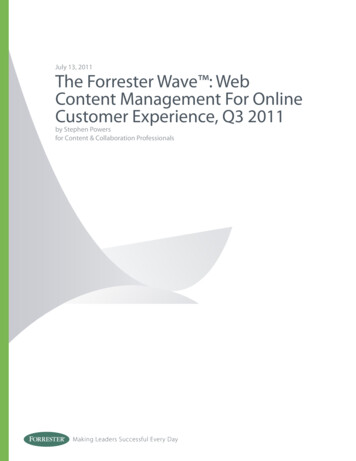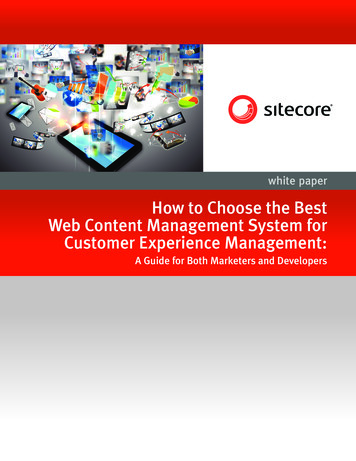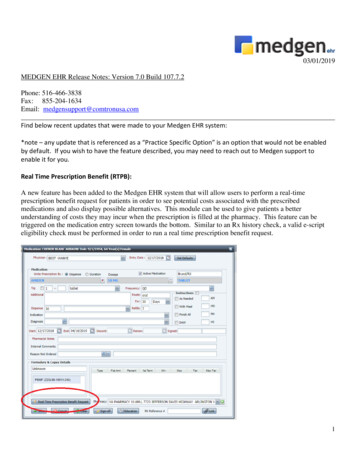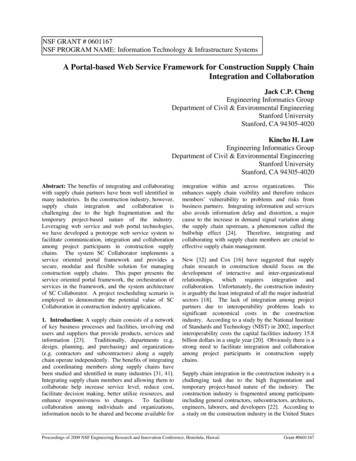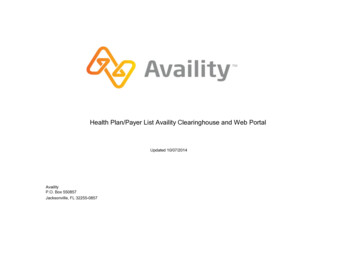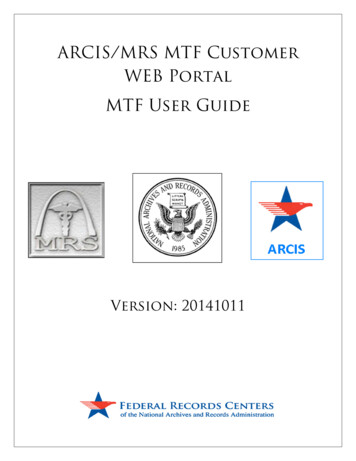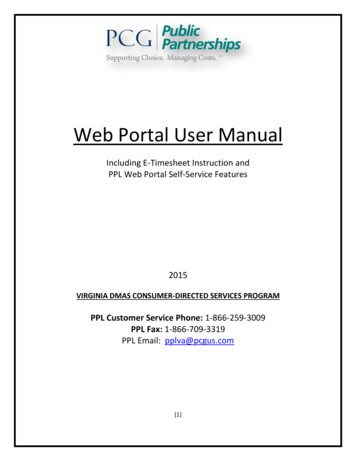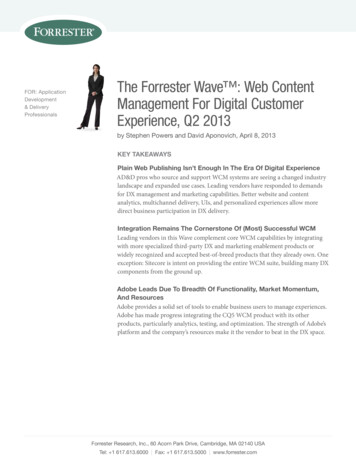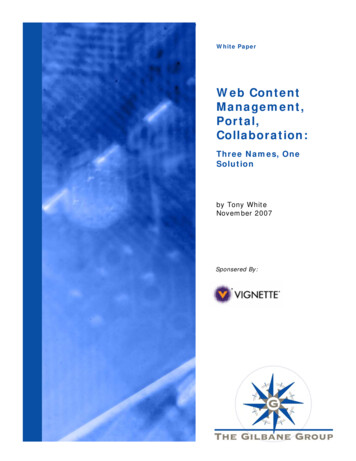
Transcription
Web Content Management, Portal, CollaborationWhite PaperWeb ContentManagement,Portal,Collaboration:Three Names, OneSolutionby Tony WhiteNovember 2007Sponsered By:
Gilbane Group Inc.763 Massachusetts AvenueCambridge, MA 02139 USATel: 617.497.9443Fax: 617.497.5256info@gilbane.comhttp://gilbane.com2
Table of ContentsExecutive Summary . 4Introduction . 5Variations on One Problem Require a Single, Comprehensive Solution .5Use Case One . 8Use Case Two.10Use Case Three .12About Vignette.143
Executive SummaryCompanies often approach the problem of getting the right information to and from theright people at the right time without thoroughly considering the entirety of what needsto be communicated or how it should be delivered. As related to internal and externalWeb technologies, resolving this problem requires the delivery of timely, relevant, andcompelling information through Web content management solutions, the targeting ofinformation to specific content consumers through portal applications, and theinclusion of feedback in multi-directional information exchanges through collaborationtechnologies. Addressing the issue holistically requires each of the three components:WCM, portal, and collaboration.WCM provides the ability for the enterprise to present its best face to the world withoutknowing anything about who’s looking. Portal refines this into a presentation based onwhat is known or what is learned about the observer. Finally, collaboration incorporatesobservers’ feedback into a process that changes the process itself. Ultimately, withoutWCM, there is no online brand. Without portal, there is no targeting. Withoutcollaboration, there is no improvement.4
IntroductionConsider the multinational law firm that needs to improve the quality of its Webpresence, reduce the complexity of creating and maintaining content for its internal andexternal Web sites, target specific content to individual employees, incorporatemultimedia content from guest contributors and business partners into its Web site,and integrate the “overall solution” with an existing enterprise CRM application.Next, think about the healthcare and medical research organization that wants to parlaythe influence and prestige of its internationally-acclaimed academic publications to itsonline brand, target highly relevant articles to specific physicians and special interestgroups, and elicit feedback from patients both on the usefulness of its Web content andthe usabilty of the Web site itself.Finally, contemplate the municipal tourism board that hopes to launch a profitable,travel-related Web portal that will attract business and leisure travelers by providinghigh-quality, interactive, informational resources linked to the retail and service Websites of local and regional merchants. As part of continuous improvement initiatives,the underlying solution will need to incorporate feedback from customers who transactbusiness through the portal.The goal of this white paper will be to explain how the people, process, and technologyin these actual scenarios relate to Web content management, portal, and collaborationsolutions. More precisely, the paper will attempt to map the components of these typesof solutions to the specific parts of the scenarios above where they fit best. But first, wewill discuss some of the typical ways companies come to decide they need WCM, portal,or collaboration technologies in the first place.Next, we will address the issue of how best to get the right information to the rightpeople at the right time. We will subsequently examine the three Gilbane clientscenarios above. And finally, we will provide perspective on how often the dilemmas inscenarios like these can be satisfied with discrete WCM, portal, or collaborationproducts.Variations on One Problem Require a Single,Comprehensive SolutionToo often, companies assess their needs for a Web content management application, aportal solution, and collaboration tools as independent projects. These initiatives popup as a result of business stakeholders inheriting responsibility for “the WCMproblem,” usually definable in terms of a general corporate feeling of “losing ground tocompetitors on the Web,” an isolated incident that draws attention to the deficiencies ofa company’s Web site, or from a CTO who senses that “the WCM application isn’tkeeping pace with other enterprise IT applications.” Alternatively, an LOB manager orexecutive may inherit responsibility for replacing the enterprise portal because “peopleare not getting the information they need from our intranet” or because “we need oneplace where people can go to get company information.” Content may be languishing in5
isolated repositories, and it is “the portal’s role to expose it all.” Alternatively, a directorof project management at a large corporation may become frustrated that all of histeams are creating the same materials over and over from scratch, wasting everyone’stime. He has tried to set up processes for getting people to share information, but hisattempts have had only a short-lived effect or none at all. Workflow has continued toconsist of people e-mailing documents back and forth. All involved say, “Oh yes, itwould be great for everyone to share information. We would all save so much time, ifonly ” But in the end, people and process remain the same, despite these thwartedefforts.The answer to the question, “What does each of these problematic situations have incommon?” is that they all require access to content—usually much of the same content.Although the instance of technology that provides the solution to each problem variesfrom the others, every problem in the scenario above fundamentally rests on theinability of the business manager or executive to make effective use of content. In onescenario, the content is managed for the Web. In another, content is managed for theportal. And in the remaining one, content is managed for a group of people engaged onthe same project or interested in similar topics.The ideal solution to these problems does not come in three discrete parts. In fact, these“problems” are really not plural in number. They all reduce to an inability to make themost effective use of content in three user scenarios. This is a single business problemto which the best solution is a cohesive, comprehensive one that leverages the value ofcontent for the entire enterprise audience. The diagram below provides a general viewof the people, process, and technology involved in the solution to all variations on theproblems above.6
Figure 1. Comprehensive Web solutions include the WCM and portal applicationsrequired to manage and display content as well as robust collaborationcapabilities on both sides of the firewall.7
Use Case OneGilbane Client: Multinational law firm seeking a “WCM solution”A multinational law firm recently engaged the Gilbane Group in a consulting projectaimed at the recommendation of a “WCM solution” that would allow them to: Maintain and extend the quality of their online Web presence Reduce the complexity of creating and maintaining content for their internaland external Web sites Target content to specific employees Include multimedia in their Web sites from occasional or guest participants Integrate existing desktop applications such as Microsoft Outlook as well asproprietary client-focused applications with the recommended “WCM solution”Here is a visual representation of what the client wanted to achieve:Figure 2. The people, process, and technology of the comprehensive Web solutionform a integral whole and cannot logically be separated.Given these goals, it became clear that the solution would have to include not only aWCM application, but also components of a portal solution and robust collaborationtools.For the four years prior to project onset, the firm had been managing its intranet,internet, and extranet sites separately, with less-than-optimal content sharing. The8
tools and technologies used to manage these sites were often discrete and dissimilar.The processes used for the creation, deployment, and maintenance of sites were laborintensive, varied, and—because the people involved sometimes had little interactionwith each other—redundant. In short, the firm’s information technology departmenthad built from scratch an in-house content management application along with amultitude of stand-alone supporting applications that on the whole did not allow for thedelivery of the right information to the right people at the right time. While the abilityto manage basic content for static Web sites was in place, there was no automatedworkflow, content asset versioning, page templating, or common repository services.The firm needed an enterprise-scale WCM solution. There was also no way topersonalize content for specific consumers. The firm needed a portal solution.Furthermore, there was no option for dynamically including people or their feedback incontent-related processes. The firm needed a collaboration solution. Of course itrequired the presentation of its “best face” on the Web, but it also needed the timely,relevant, and compelling delivery of targeted content to employees and customers aswell as the inclusion of feedback from those customers in reports to attorneys. In sum,the firm thought it needed a WCM solution. What it needed was a WCM-portalcollaboration solution.9
Use Case TwoGilbane Client: International healthcare and medical researchorganization inquiring about “WCM and Portal”In a recent client inquiry from a well-known healthcare and medical researchorganization, Gilbane was asked about the defining differences between WCMapplications and portal applications. The client said it wanted to know for threereasons: (1) the pervasiveness of confusing information on solution providers’ Websites; (2) apparent overlaps in the functionality between the two product categories;and (3) suspicion that their requirements bridged product boundaries. Our responsewas as follows:“This question has two answers—a theoretical one and a practical one. In theory,portals provide a doorway (portal Latin porta, gate) that, when opened, allowscontent consumers to view a particular set of content. The exact set of content to whichconsumers are exposed is (a) dynamic, and (b) controllable, either by the applicationadministrator or by the consumers themselves. Because the function of the portalessentially rests in this “doorway” or “frame” function, some customers see portalsoftware as an empty shell or framework, with a set of underlying services, to whichcontent-connected portlets can be added. WCM applications, on the other hand,theoretically provide all of the features and functions required to create, manage,expire, and archive content. This feature set typically includes authoring and editingtools for multiple content types, automated workflow, versioning, audit control,channel management, metadata management, library services, templating, accesscontrols, etc.“In practice, however, the feature sets of WCM and portal applications often overlap.One vendor’s portal product might provide the same feature as another vendor’s WCMapplication. Because portals are composite applications that expose componentapplications, this phenomenon may also extend to products or modules such as ERP,CRM, search, collaboration, campaign management, etc. For this reason, depending onhow vendors group features and functions in their product offerings, any given set ofWCM or portal requirements may be satisfied by a variety of product combinations.One vendor’s WCM application may suffice. Another vendor’s portal product may alsobe a good fit. And a third vendor’s solution may include WCM, portal, and collaborationmodules.“Because of this variation in vendors’ grouping and naming conventions, Gilbaneclients should, during the technology selection process, seek solutions to their set ofcontent technology problems without becoming distracted by the exact names ornumber of modules or products required to provide the solution. Let vendors includewhatever products they wish in their RFP responses, but hold them responsible for (a)satisfying every requirement, (b) identifying the modules that satisfy each requirement,and (c) giving a total price for all of the modules included in the response. In the end,“WCM and portal” by any other name is still “WCM and portal.”10
Figure 3. On the left, we see a random content consumer on the Web viewing astatic homepage managed by a WCM system. Nothing about the consumer affectsthe Web page’s content. On the right, we see a particular content consumerviewing a customized instance of a Web page managed by a WCM system andpersonalized by a portal application, which creates unique combinations ofcontent based on stated user preferences and observed online behavior.To that, we would add that clients should always ask themselves whether their goal issimply to deliver compelling content online. If the answer is “yes,” then they shouldconsider a best-of-breed WCM application. Should they also want to control whichinformation is delivered or to whom information is delivered based on the profile of theconsumer, they should also consider a portal solution. And finally, if they want a multidirectional flow of information—in order to improve business processes, for example—they should also consider collaboration products. A WCM-portal-collaboration solutionbecomes necessary whenever people and process need to interact iteratively to achievebusiness goals such as improved customer service, higher quality product development,or more effective continuous improvement initiatives.“A WCM-portal-collaboration solution becomes necessary whenever peopleand process need to interact iteratively to achieve business goals such asimproved customer service, higher quality product development, or moreeffective continuous improvement initiatives.”11
Use Case ThreeMunicipal tourism board seeking a “WCM solution” in order todevelop a travel portal with “strong social aspects”Currently, the Gilbane Group is working with the tourism board of a large municipalityto help them choose the right technology solution for their travel and tourism portal.The travel and tourism industry represents one of the largest revenue streams for thecity and its businesses, and the need for getting information about the city to potentialleisure and business travelers—and to the city’s businesses that stand to sell goods andservices to those travelers—is critical to the city’s economic viability. The tourism boardhas also stated that it is critical for them to understand the sales conversions rates(percentage of those expressing interest in goods and services who actually makepurchases) on their own and their partners’ Web sites as well as to get feedback fromcustomers regarding what information was useful and what was not. To be successful,the travel and tourism portal needs to display information about the goods and servicesthe city has to offer, both to individuals and businesses, based on their particularinterests. So that the quality and profitability of the site improves over time, the portalalso needs to incorporate feedback from content consumers themselves into ongoingWeb site improvement initiatives. The city’s generic description of the goal is “to have auseful, profitable, highly interactive travel Web site that generates interest in andrevenue for the city’.”WCMPortalCollaborationEnterpriseDoes the solutionsuccessfullypromote theonline brand?Does the solutionimprovepenetration of thetarget audience?Does the solutionsupport processimprovementthrough ation UsersIs the feature setcomplete andeasy to use?Is the feature setcomplete andeasy to use?Is the feature setcomplete andeasy to use?Can I find theinformation Iwant?Do Iautomatically getthe information Iwant, whether Iknew I wanted itor not?Can I givefeedback on whatneeds to bechanged?AudienceOnlineInformationConsumersFigure 4.12
Figure 5. A personalized instance of a Web site delivered to a specific consumerbased on his interests. Note that the flow of information is bi-directional—the siteaccepts user feedback. This representation of a WCM Portal Collaborationsolution is essentially what the municipal tourism board needs.“People, Process, and Technology” – Getting the RightInformation To and From the Right People at the Right TimeTo be sure, the individual components of an overall WCM-Portal-Collaboration solutioninvolve different combinations of people, process, and technology. But the goal ofdelivering the right information to and from the right people at the right time is aunified one, and it draws the various people, processes, and technologies together into acohesive whole that can only be assembled when all of the parts are present.Only as components of an overall solution can WCM, portal, and collaborationtechnologies comprehensively address online branding, content targeting, and processimprovement concerns.WCM provides the ability for the enterprise to present its best face to the world withoutknowing anything about who’s looking. Portal refines this into a presentation based onwhat is known or what is learned about the observer. Finally, collaboration incorporatesobservers’ feedback into a process that changes the process itself. Ultimately, withoutWCM, there is no online brand. Without portal, there is no targeting. Withoutcollaboration, there is no improvement.13
About VignetteFor over ten years, Vignette has been an undisputed leader in Web ContentManagement. The requirements of our early customers drove support for previouslyuntested tactics like personalized experiences, online social networking, and a widerange of content types. The key to their success of all of these customers was Vignette’sability to help them both manage and deliver vast amounts of content.Today, organizations’ aspirations are far more sophisticated than simply providing acompelling Web site. They expect to fully exercise the Web as a vehicle for managingevery aspect of the customer experience.Vignette’s technology offerings have also grown in sophistication. Today we address thebroad next-generation Web initiatives of large organizations in virtually every industry.We make it possible for our customers to provide online experiences that are personal,social, and available from virtually any device or channel. Everything we do is aboutenriching and optimizing the online experience—for customers, employees, partners,patients, constituents, and any other significant audience.Our solution includes content management, portal, and collaboration products thatconsistently gain third party recognition, as well as adoption by some of the world’smost powerful online brands. Our three core products work together and can be used inany combination to create the quality and quantity of online interactions that each ofour customers requires.Vignette is headquartered in Austin, Texas with operations worldwide.14
About Vignette.14 3. Executive Summary Companies often approach the problem of getting the right information to and from the . compelling information through Web content management solutions, the targeting of information to specif
